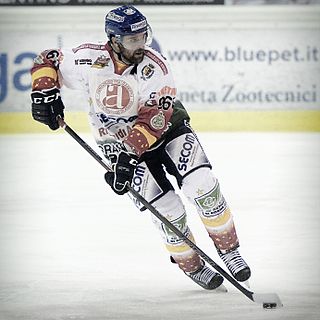Related Research Articles

Plus−minus is a sports statistic used to measure a player's impact, represented by the difference between their team's total scoring versus their opponent's when the player is in the game.

In ice hockey, a goal is scored when the puck entirely crosses the goal line between the two goal posts and below the goal crossbar. A goal awards one point to the team attacking the goal scored upon, regardless of which team the player who actually deflected the puck into the goal belongs to. Typically, a player on the team attempting to score shoots the puck with their stick towards the goal net opening, and a player on the opposing team called a goaltender tries to block the shot to prevent a goal from being scored against their team.
Short-handed is a term used in ice hockey and several related sports, including water polo, and refers to having fewer players on the ice during play, as a result of a penalty. The player removed from play serves the penalty in the penalty box for a set amount of time proportional to the severity of the infraction. If a goaltender commits a minor infraction, another player who was on the ice at the time of the penalty serves, often but not necessarily the team captain.

A penalty in ice hockey is a punishment for an infringement of the rules. Most penalties are enforced by sending the offending player to a penalty box for a set number of minutes. During the penalty the player may not participate in play. Penalties are called and enforced by the referee, or in some cases, the linesman. The offending team may not replace the player on the ice, leaving them short-handed as opposed to full strength. When the opposing team is said to be on a power play, they will have one more player on the ice than the short-handed team. The short-handed team is said to be "on the penalty kill" until the penalty expires and the penalized player returns to play. While standards vary somewhat between leagues, most leagues recognize several common varieties of penalties, as well as common infractions.
In ice hockey, a penalty shot is a type of penalty awarded when a team loses a clear scoring opportunity on a breakaway because of a foul committed by an opposing player. A player from the non-offending team is given an attempt to score a goal without opposition from any defending players except the goaltender. This is the same type of shot used in a shootout to decide games in some leagues.
The following are statistics commonly tracked in ice hockey.
James Corsi is a Canadian-Italian former professional ice hockey goaltender and the current goaltending coach for the Columbus Blue Jackets. He was previously the goaltender coach of the St. Louis Blues and the Buffalo Sabres. Before beginning his hockey career, Corsi also played soccer at the professional level as a forward in the North American Soccer League for the Montreal Olympique. The following season he played in the National Soccer League with the Quebec Selects.
Full strength in ice hockey refers to when both teams have five skaters and one goaltender on the ice. The official term used by the National Hockey League (NHL) is at even strength — abbreviated EV on official scoresheets and goaltenders' individual stats. All games start with both teams at full strength. Teams that take a penalty, go on the power play, or pull the goalie are no longer at full strength.
This is a list of common terms used in the sport of ice hockey along with the definitions of these terms.
Darcy John Regier is a Canadian professional ice hockey executive and former player. Regier was general manager of the Buffalo Sabres in the National Hockey League from 1997 until 2013. He was the longest-serving and winningest GM in Sabres history. In 2014, he became a senior vice president and assistant general manager with the Arizona Coyotes, ending his tenure with Arizona in 2016. Regier played 26 games in the NHL for the Cleveland Barons and New York Islanders as a defenseman.

Michele Strazzabosco is an Italian former ice hockey defenseman. He played for two decades in the top Italian ice hockey league and was a member of the Italian national ice hockey team for a dozen years, including at the 2006 Winter Olympics in Turin. Strazzabosco is considered one of the top native players in Italian ice hockey history.
The 2006–07 Buffalo Sabres season was the 37th season of operation, 36th season of play, for the National Hockey League franchise that was established on May 22, 1970. The Season began with the team attempting to rebound from a disappointing end to the 2005–06 season, in which the Sabres advanced to the Eastern Conference Finals before losing in seven to the eventual Stanley Cup Champions, the Carolina Hurricanes.
The 1998–99 Buffalo Sabres season was the Sabres' 29th season in the National Hockey League. Miroslav Satan scored 40 goals and the Sabres would add influential centers Stu Barnes and Joe Juneau from the Pittsburgh Penguins and Washington Capitals, respectively. Michal Grosek had the best season of his career, and the team finally returned to the Stanley Cup Finals, which was a losing effort against the Dallas Stars.

Bradford Sabres is an English ice hockey team that played in Division 2 of North league of the British Universities Ice Hockey Association. They played their home games at the Bradford Ice Arena, Bradford, West Yorkshire. They were formed in 2005.
The 2000–01 Buffalo Sabres season was the 31st season for the team in the National Hockey League (NHL). The Sabres finished with a 46–30–5–1 record in the regular season, and won the Conference Quarterfinals (4–2) over the Philadelphia Flyers, but lost the Conference Semifinals (4–3) to the Pittsburgh Penguins. It was also the final time they made the playoffs before the 2004–05 NHL lockout.

Zack Adam Kassian is a Canadian professional ice hockey winger who is an unrestricted free agent. He is currently signed to a professional tryout agreement with the Anaheim Ducks in the National Hockey League (NHL). During his junior career, he won a Memorial Cup with the Windsor Spitfires in 2010. Selected 13th overall in the 2009 NHL Entry Draft, he began his career within the Buffalo Sabres organization before being traded to the Canucks in 2012. He played parts of four seasons with the Canucks before they traded him to the Montreal Canadiens in 2015. Kassian never played for the Canadiens as he was suspended for substance abuse issues, and was traded to the Oilers a few months later.

Jack Robert Eichel is an American professional ice hockey center for the Vegas Golden Knights of the National Hockey League (NHL). Eichel was selected second overall in the 2015 NHL Entry Draft by the Buffalo Sabres. Before entering the league, Eichel was described at the age of 17 as "the new face of American hockey," and he was considered a member of a rising class of generational talents in the sport.
In ice hockey, analytics is the analysis of the characteristics of hockey players and teams through the use of statistics and other tools to gain a greater understanding of the effects of their performance. Three commonly used basic statistics in ice hockey analytics are "Corsi" and "Fenwick", both of which use shot attempts to approximate puck possession, and "PDO", which is often considered a measure of luck. However, new statistics are being created every year, with "RAPM", regularized adjusted plus-minus, and "xG", expected goals, being created very recently in regards to hockey even though they have been around in other sports before. RAPM tries to isolate a players play driving ability based on multiple factors, while xG tries to show how many goals a player should be expected to add to their team independent of shooting and goalie talent.
Fenwick is an advanced statistic used in the National Hockey League to measure shot attempt differential while playing at even strength. It is also known as unblocked shot attempts (USAT) by the NHL. This includes shots on goal and missed shots on goal towards the opposition’s net minus the same shot attempts directed at your own team’s net. Unlike Corsi, it does not include blocked shot attempts.
References
- ↑ McKenzie, Bob (6 October 2014). "McKenzie: The real story of how Corsi got its name". www.tsn.ca. Bell Media. Retrieved 2 February 2015.
- ↑ "Hockey Reference Player Advanced Stats Finder". hockey-reference.com. Retrieved 26 October 2018.
- ↑ "Rink Stats | Why we should be trying to do better than Corsi and Fenwick".
- ↑ "The Ten Laws of Hockey Analytics". 18 January 2008.
- ↑ "Team Season Totals - Natural Stat Trick".
- ↑ Staples, David. "Why Corsi numbers are an unreliable base stat for rating players". blogs.edmontonjournal.com. Edmonton Journal. Retrieved 3 February 2015.
- ↑ "Connor McDavid - Summary - Natural Stat Trick".
- ↑ "Pierre-Edouard Bellemare - Summary - Natural Stat Trick".